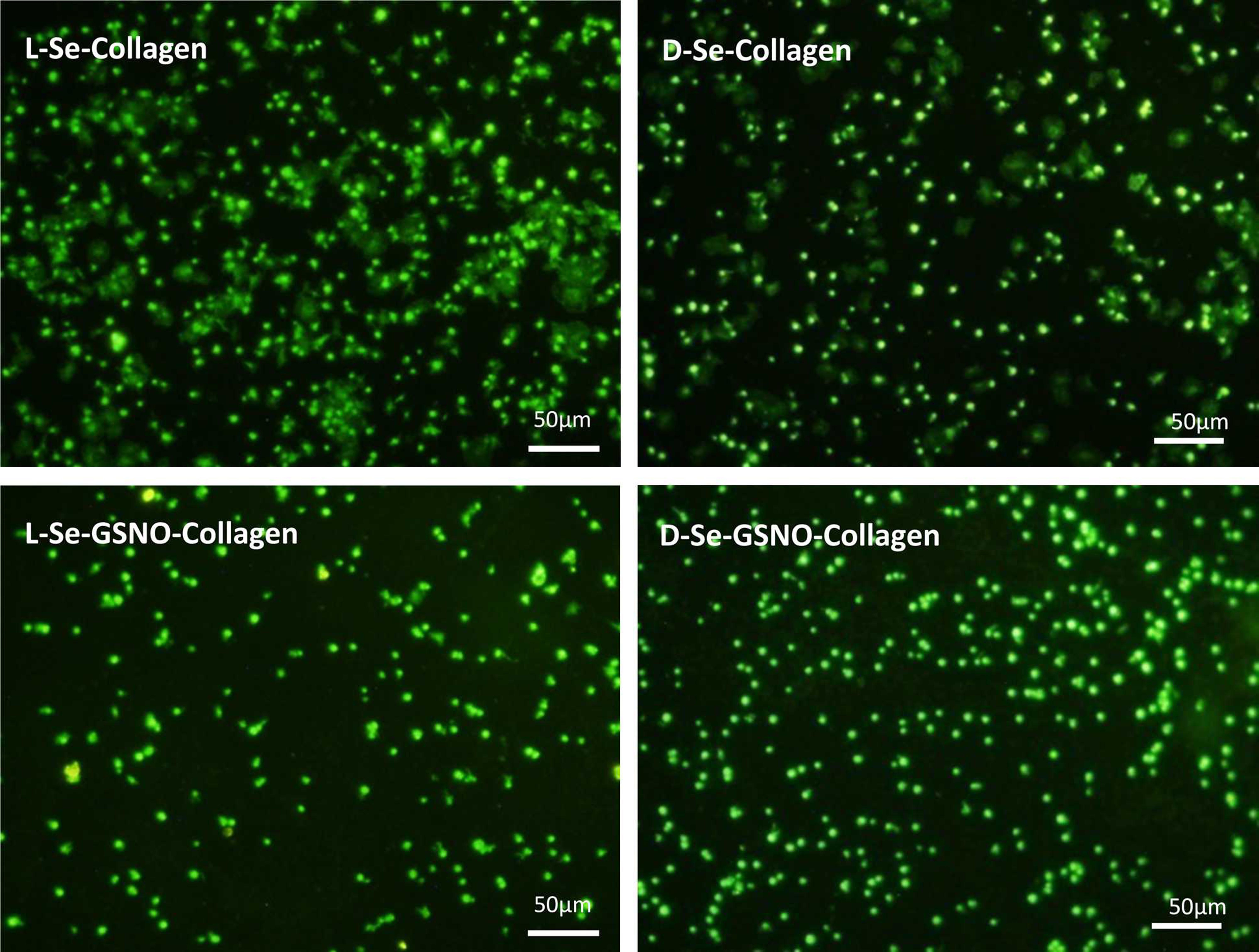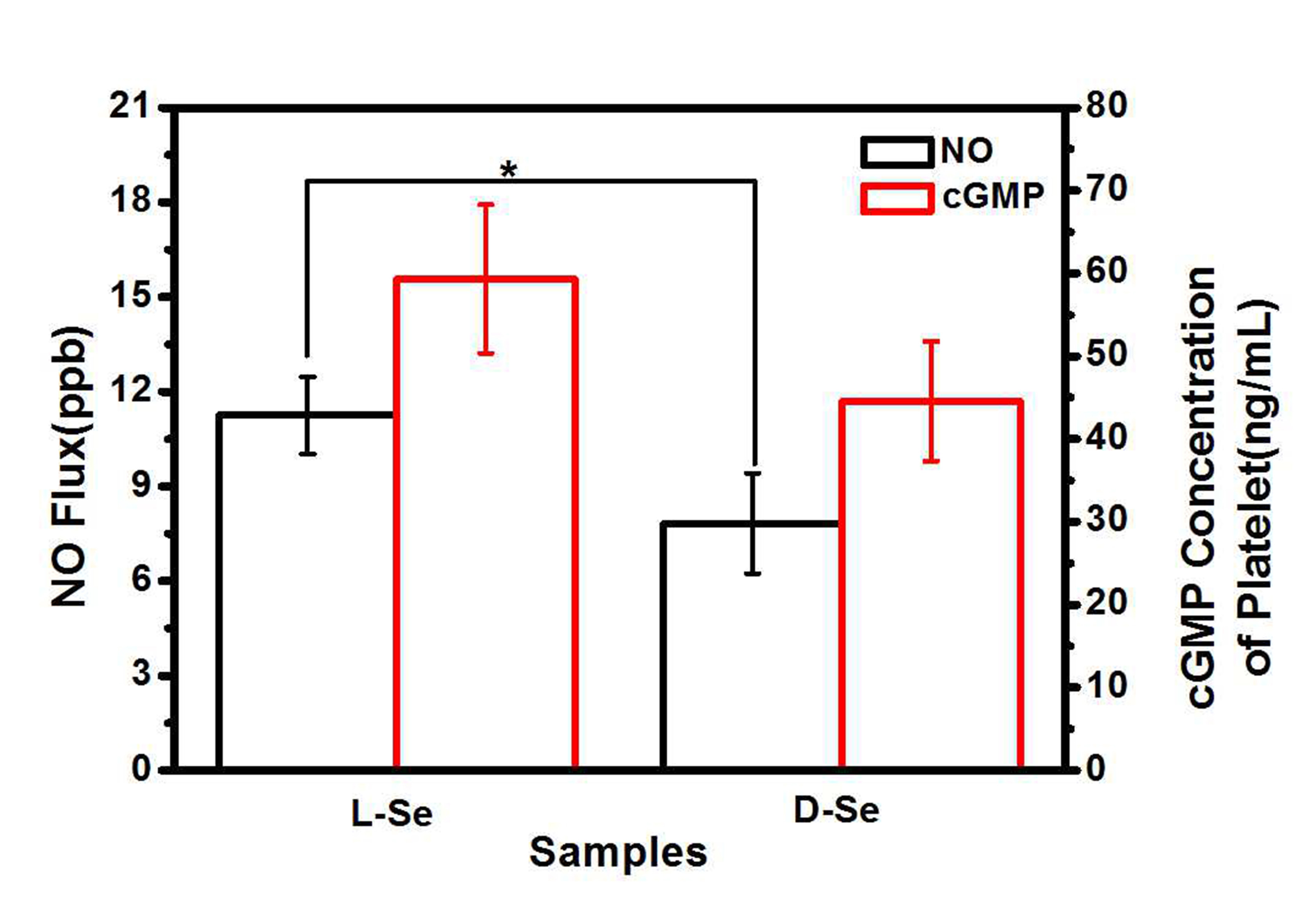Introduction As Nitic Oxide (NO) plays vital roles in cardiovascular system,some molecules with ability to catalyze S−nitrosothiols release NO were immobilized on biomaterial surfaces to mimic the inner layer of the blood vessel for good hemocompatibility.[1] Also, various biological processes and behaviors were regulated by chiral recognition on the interfaces of cells,[2][3] tissues or organs.[4]Either achiral catalytic molecules or only one kind of chiral catalytic molecules was used in the previous studies.[5][6] Thus, the influence of different chirality on catalytic activity and hemocompatibility is a far less known. In this study, selenocystine with different chiralities (L- and D−selenocystine) was used as the catalytic molecule to be immobilized on TiO2 films for decomposing endogenous NO donors, and the influence of surface chirality on NO releasing and platelet behavior was evaluated.
Materials and methods A mussel inspired plydopamine coating was used as a linker for immobilization of selenocystine. Five-layer polydopamine was prepared as described in the literature.[7] L- or D-selenocystine was then immobilized by incubating samples into a 3 mM selenocystine solution at 37℃ for 12h and washed with distilled water. The samples were referred to as L−Se, D−Se.Quartz crystal microblance with dissipation (QCM)was used to detect protein adsorption. NO releasing was monitored by chemiluminescence method, platelet adhesion and cGMP test were performed as well.
Results and Discussion In vitro catalytic NO releasing tests showed that the L-Se had more ability to catalyze decomposition of S-nitrosoglutathione (GSNO). Additionally,BSA and Fg as model proteins were tested by QCM, and it showed the L-Se was beneficial for protein adsorption.Platelet adhesion on the D-Se decreased compared with that on the L- Se. However, as GSNO is present, the L-Se showed significantly better inhibition effects and higher cGMP concentration than that of the D-Se with more NO generating. The above results showed that chiral surfaces with or without NO releasing acted in different ways in regulating NO generation and platelet behavior.

Figure 1 NO release and cGMP analysis. (mean±SD, p<0.05, t-test)

Figure 2 Immunofluoresent images of platelet adhesion on L-Se and D-Se, collagen was added as an activator in this experiment.
Conclusion In summary, chiral selenocystine was immobilized on TiO2 via polydopamine transition layer in this study. Although L- or D- selenocystine immobilized surfaces had similar surface constitution and hydrophilicity, surfaces modified by L- selenocystine showed better ability in protein adsorption, generation of NO and inhibition of platelet adhesion and activation. This material will facilitate the research on natural chiral phenomena, and certainly return more valuable information for the design of biomaterials.
National Natural Science Foundation of China (No. 31200725); Key Basic Research Project (No.2011CB606204); Sichuan Province Science Foundation for Youths (No.2013JQ0043); Fundamental Research Funds for the Central Universities (2682014CX006)
References:
[1] A. Mel, F. Murad and A. M. Seifalian, Chemical reviews, 2011, 111, 5742-5767.
[2] T. H. Sun, D., J. AM. CHEM. SOC., 2007, 129, 1496-1497.
[3] M. Li, G. Qing, M. Zhang and T. Sun, Science China Chemistry, 2014, 57, 540-551.
[4] M. Zhang, G. Qing and T. Sun, Chemical Society reviews, 2012, 41, 1972-1984.
[5] X. Duan and R. S. Lewis, Biomaterials, 2002, 23, 1197-1203.
[6] W. Cha and M. E. Meyerhoff, Biomaterials, 2007, 28, 19-27.
[7] Y. Weng, Q. Song, Y. Zhou, L. Zhang, J. Wang, J. Chen, Y. Leng, S. Li and N. Huang, Biomaterials, 2011, 32, 1253-1263.